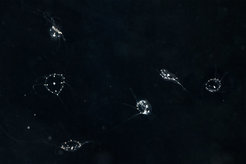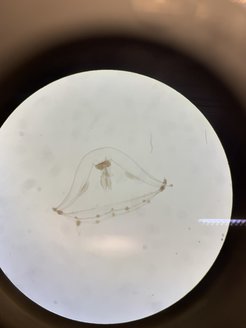Jellyfish Science
What do vacations by the sea and basic scientific research have in common? At least at the MPI-NAT, the answer is: jellyfish. Here, our scientists study the living eggs of these small saltwater animals.

Tiny, transparent, hardly distinguishable from air bubbles: The jellyfish at the MPI-NAT are different from those you encounter on a dive or in an animal documentary. Even when fully grown, the specimens of Clytia hemisphaerica are a maximum of one centimeter in size. In their acrylic glass box, they swirl around in a constant artificial current, without which they would sink to the ground and die. “When the jellyfish hatch, they are about the size of a pinhead. They then grow for another two to four weeks until they are the size the researchers need them to be,” explains animal keeper Sascha Krause. He looks after the jellyfish in our institute’s aquariums; he feeds them, cleans their saltwater tanks, and keeps them healthy for the scientists’ work. This animal model is not new in basic research, but it is still unusual. In 2020, the jellyfish came to the Fassberg – inspired by the work of a research group at the Laboratory of Developmental Biology in Nice (France) which also supports the implementation of the model at our institute.
Transparent oogenesis
At our institute, the Cytoskeletal Dynamics in Oocytes research group and the Facility for Light Microscopy, both led by Peter Lenart, use the animals to study live oocytes. “The isolated ovaries of jellyfish are very well suited for live cell microscopy,” Lenart says, explaining, “In jellyfish, a large part of oogenesis – that is, the growth phase and also the meiosis of an egg – happens within 24 hours. With the animals, we can follow how oogenesis proceeds in living cells.” Being naturally transparent is another advantage of the jellyfish: “Oocytes or ovaries from most animals are not transparent, making them difficult to microscope,” reports Jasmin Jakobi, technical assistant on Lenart’s team. “It takes a lot of prep time, long protocols, and chemicals to make them transparent.” Jellyfish, on the other hand, can be viewed alive under a microscope without much preparation, she says.
Jellyfish at an advantage

Other strengths of jellyfish: Thanks to a very fast life cycle and their cultivation in the lab, they can also be genetically matched to the scientists’ research. For example, researchers can use the CRISPR/Cas9 method to specifically alter DNA building blocks in the animals’ genome. In addition, starfish – neighbors of our jellyfish in animal husbandry and the animal model Lenart and his team are currently mainly working with – have some disadvantages. Since starfish cannot be bred under laboratory conditions, for example, our institute works with wild-caught animals from California. So, not only the long journey, but also climate change and pollution of their natural environment have an impact on the animals’ health. Genetic manipulation is also impossible with them. Plus: “In cell and developmental biology, we still focus on very few model systems. These model systems are great because you can study conserved mechanisms in detail,” Lenart says. “But diversity is just as exciting. And that we understand less because we are so focused.” Jellyfish and even starfish are unusual model systems, he says – and that enriches research: “Nature is diverse, and when you start with something new, sometimes you suddenly see that it is a little different and exciting.”
Jasmin Jakobi is fascinated by something else about jellyfish: “When you remove the ovaries, they survive for another two or three days and continue to produce eggs.” Once the ovaries are no longer in a jellyfish, they form hair-like cell projections called cilia, which they could use to move through the water. “The immature eggs in the ovaries are even digested to allow the more mature eggs to grow to the end in order to secrete them.” The best conditions for live cell microscopy.
A model for the future

Lenart would like to continue his work with Clytia hemisphaerica in the future: “We have great hope regarding our research with jellyfish. For the next few years, I envision us using starfish and jellyfish models at the same time. If that works well, I would like to move completely to the jellyfish. We want to continue to look at oogenesis, and this is a very good system for that.” Sascha Krause can well imagine the switch to jellyfish, too, but also sees the challenges that the husbandry brings with it: “In the future, we want to produce 200 to 300 jellyfish per week. If everything goes well, that is feasible – but with feeding and cleaning the boxes on that scale, it is also going to be a lot of work.” In addition to that, jellyfish are more demanding than starfish when it comes to their habitat, he says. “Jellyfish are quite sensitive to fluctuations in water values, for example temperature or salinity. Getting all that right is quite a challenge."
Lenart appreciates that effort: “I am very grateful that the Animal Facility here is so excellent, that the people there put so much effort into their work and are so supportive. The colleagues are really great and very dedicated," says the research group leader. “It is extremely tedious and time-consuming to establish such a system. It can take one to two years before it is really up and running. That is the phase we are in now. Hopefully, by the end of this year, we can really say, ‘Everything is running stable now.’” (kf)


